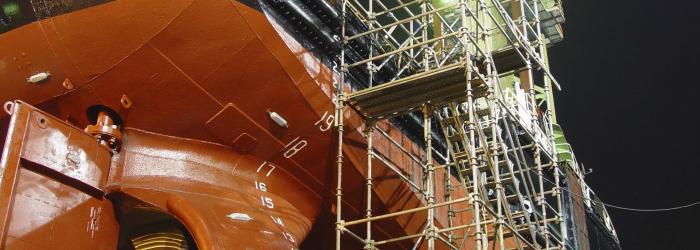
The future of shipbuilding is an interesting topic, especially for anyone in the shipbuilding industry:). It is no secret that shipbuilding has not really embraced new and mature technologies as rapidly as other industries. There are many reasons for this and that topic can be the source of passionate debates. The question is, will the future of shipbuilding take a similar path as it has in the past, or are we at a tipping point leading to a significant change in the way we build ships?

Digital Shipbuilding
Get a first-hand experience of what the design, build, and maintenance phases are like in an increasingly digital shipyard.
Experience nowI for one think that shipbuilding is going to go through a transformation. There are many factors that will cause us to change and it is not just technology. In my opinion, enhancements in technology are just the enabler. The real drivers are customer requirements due to new markets, regulations and requirements as well as the need to build more complex ships in a shorter time frame and at a lower cost. Related to all those items are the hard times that the shipbuilding industry is facing which is the reason why most industries go through a transformation.
This series of blog posts will be focused on the future of shipbuilding using new technologies but the focus will not be on technology itself. We are in the business of shipbuilding and using technology just enables us to improve our end result. The fact remains that shipbuilding does not need to be on the cutting edge of technology to see change but rather use mature technology to solve the new problems and constraints we have today. I should give the disclaimer that I will discuss using some relatively new technologies which are not yet mature enough to solve some of our challenges since I am talking about the future of shipbuilding:). To provide you some context I am looking at what shipbuilding can look like in 15 years.
Why Now?
When some of us think of innovation, we think of one technology or one thing that is innovative. The reality is that Innovation is never a single event. If you look at anything you think is innovative I am sure you can also find an adjacent innovative thing. For example, think of social networks such as Facebook, Twitter or LinkedIn. The innovation of these social networks could not have happened if we did not have the internet, mobile devices such as smartphones and tablets, improved cellular data coverage at reasonable costs to allow users to always be connected, and even the culture change of wanting to share absolutely everything about ourselves including what we ate for dinner.
An innovation more related to shipbuilding is the 3D Laser Scanner. 3D capturing devices have been around for a long time, so why has it really only been recently that 3D laser scanning is becoming common place? I actually wrote a blog post about this Increased Investment in Reality Capture. One reason is because laser scanners have significantly dropped in price. However, just importantly is the fact that the software to processes the captured data now requires very little training or knowledge to use. Another factor is that most of the CAD software we use today can now handle enormously large point cloud datasets generated in shipbuilding at virtually little to no additional investment. The combination of these factors has led to the recent increased utilization of laser scanning in shipbuilding. One of them on its own would not be enough.
That leads me to my next point. There is a lot of discussion as to whether or not we are actually being more innovative today than in the past as many supposedly new technologies have actually been around for decades. I will not get into this debate; however, I think one thing to note is that innovation in one technology area is feeding innovation in other technologies which itself is in a self-perpetuating feedback loop with other technology. So any small enhancement in one technology area is also providing improvements in a totally separate technology area. This means that there is a broader amount of technology that is increasing and allowing new opportunities.
Another example is Big Data and machine learning, which are now hot topics because of the vast amount of data that is captured. We would not have the data and the processing power to do something with it if we did not have the cloud and the applications it enabled, smartphones and many more technologies. This in turn improved Big Data analysis and machine learning algorithms which has then propelled companies to capture even more information about their product and offer new services.
IoT can be considered a technology which is driven by big data and improvements in machine learning which then also feeds more information (fuel) to those technologies.
The reason that now is the time we will see change is because there is such a broad spectrum of technologies that are all advancing at incredible speeds. We have never had so many technologies improve so rapidly and the combination of these will put many more tools in our toolbox.
What is Driving us to Change Now for the Future?
There are three very important things that will drive the change we will see in the future of shipbuilding:
- The Hard Times the Shipbuilding industry is going through
- New Customer Requirements
- Evolving Industry Trends
1. The Hard Times the Shipbuilding industry is going through
If we look at history, most companies innovate out of desperation. This is when their market share is retreating or their product and/or service is no longer wanted. This does seem counter intuitive since you would think when things are going well you will have the additional funds and flexibility to take some risk, but the reality is just the opposite. If we look at the shipbuilding industry currently, we are definitely hitting some hard times. If history does repeat itself we should see some companies take some drastic measures to become relevant again or stay as a market leader. These companies will be the first to release their baggage of traditions and solve the challenges of today’s shipbuilding with today’s tools.
2. New Customers Requirements
Customers require and demand much more sophisticated and complex ships. These requirements can be sourced from:
- Environmental Regulations: With ships accounting for 30% of the total NOx there have been several regulations that will impose a reduction in emissions of up to 70%. To reduce emissions this significantly will require dramatic changes to ships from shape of the hull, type of fuel, material used and even the type of paint required.
- Autonomous or Semi-Autonomous vessels: There is a study which estimates shortages of over 92,000 ships’ officers are expected by 2020.This is one reason there is a trend to reduce or eliminate ship staff as a top priority of many shipping companies and navies. Safety is also another driver.
- Similar or shorter delivery cycles: Producing a more complex ship is easily achievable if we had more time to design, engineer, procure material and build the ship; however, this is not a luxury that we will have. We will have to produce a more complex ship with a tighter schedule.
- Ship Service Lifecycle Management: The cost of building a ship can be a small portion compared to the operating cost of a ship for its lifespan. This will require more digital information to be transitioned to the owner when they take possession as well as require more physical instruments to be added to today’s designs. This will require inputs such as power and signal lines with redundancy which will take up additional and precious space in an already cramped ship.
- New Markets to be exploited: New markets are being discovered by various companies which did not exist in the past. These new markets will require ships with unique functions and abilities.
3. Evolving Industry Trends
Many design firms and shipyards are looking at reducing cost by reducing materials, minimizing material handling, reducing resources (man power, lift & turning, late outfitting, etc.) and at the same time improving the output quality. Here are some of the reasons that are causing change:
- Distributed Concurrent Environment: When designing and building the most complex structures humans build today, it is no surprise that there are many companies, suppliers and people involved. To reduce time to delivery there are more activities that are happening in parallel which adds additional complications. This also results in having many of the stakeholders involved to be distributed in different offices, cities and countries. Having a way to embrace this distributive environment and provide a collaborative and communicative platform is a necessity.
- Workforce: Shipbuilding is not a glamorous industry any more. It is difficult for design agencies, engineering firms and shipyards to find highly skilled workers or even bright young minds to train and educate. Technology can aid in reducing the amount of workforce required by providing more information to current designers and engineers as well as provide cyber-physical systems allowing the staff on the waterfront to accomplish their job faster.
- Quality: It does seem that quality is now appreciated again after a duration of sacrificing quality for cost. This has put a focus for our industry to be able to improve quality of every aspect of shipbuilding.
- Automation: Many of the activities we do are very manual. Many are investing in automating many of their processes from communication to driving machines from their 3D data. Automation allows a process to be repeatable, eliminates human error andallows workers to concentrate on other value-added activities. Automated processes also work on weekends and overtime at no additional cost, and in most cases can produce a better result.
Technologies
Here is a list of technologies I may discuss in this series of blog posts.
- IoT
- Artificial Intelligence / Machine Learning
- 3D Printing
- New materials such as graphene
- Augmented Reality
- Smart Information/Collaboration Management systems
- 3D Scanning/Capture
- Drones
- Big Data
- Virtual Reality
- Internet/Cloud
- Photo-identification
- Enterprise Search
- Gamification
- Simulation
- Mobile
- Nanotechnology
Closing Remarks
Change is the only constant in everything we do. I believe or at least want to believe that the future of shipbuilding will embrace new ways of building ships. I never will advocate for using a technology just for the sake of using it and I do not believe the shipbuilding industry will either. There are many technologies which have been improving exponentially because of the feedback loop relationship they have with other technologies. This means that there is a broader amount of technology we are able to use to improve every aspect of what we do today.
There are several forces driving us to change more than we had in the last few decades. The best way to solve our new challenges is to look at what tools are available today for us to leverage.
In my next few blog posts I will be going through some of the stages of shipbuilding and suggest the possibility of how we will be working 15+ years from now. I will not be going into extensive detail on each stage of shipbuilding nor will I be going into detail on the technology that can be used. This series of blog posts is simply to share a high level vision I believe can be achieved in shipbuilding in my lifetime.
Blog Posts in the Future of Shipbuilding Series
- Future of Shipbuilding (15+ years)
- Future of Shipbuilding: Engineering Design
- Future of Shipbuilding: Detail Design and Production Planning (Part 1)
- Future of Shipbuilding: Detail Design and Production Planning (Part 2)
- Future of Shipbuilding: Manufacturing (Part 1)
- Future of Shipbuilding: Manufacturing (Part 2)
- Future of Shipbuilding: The Journey Forward
